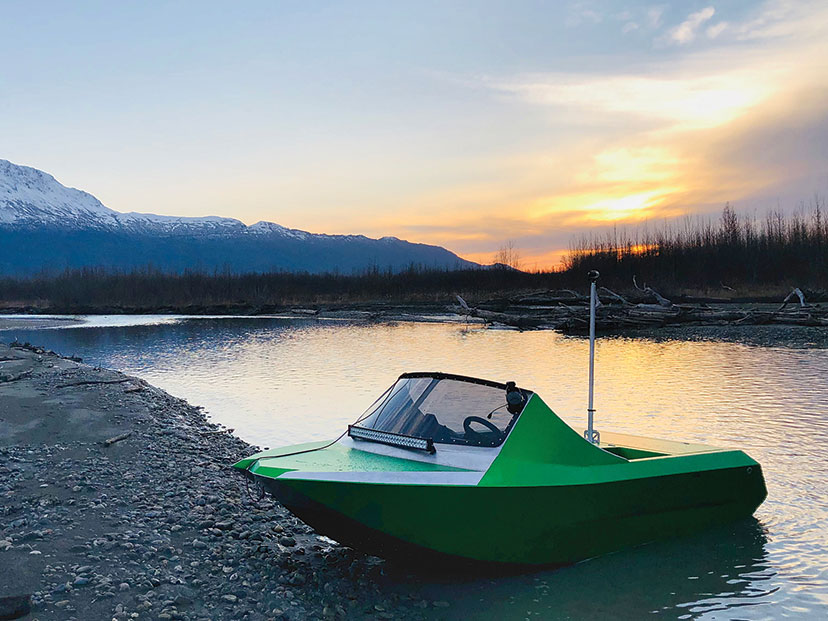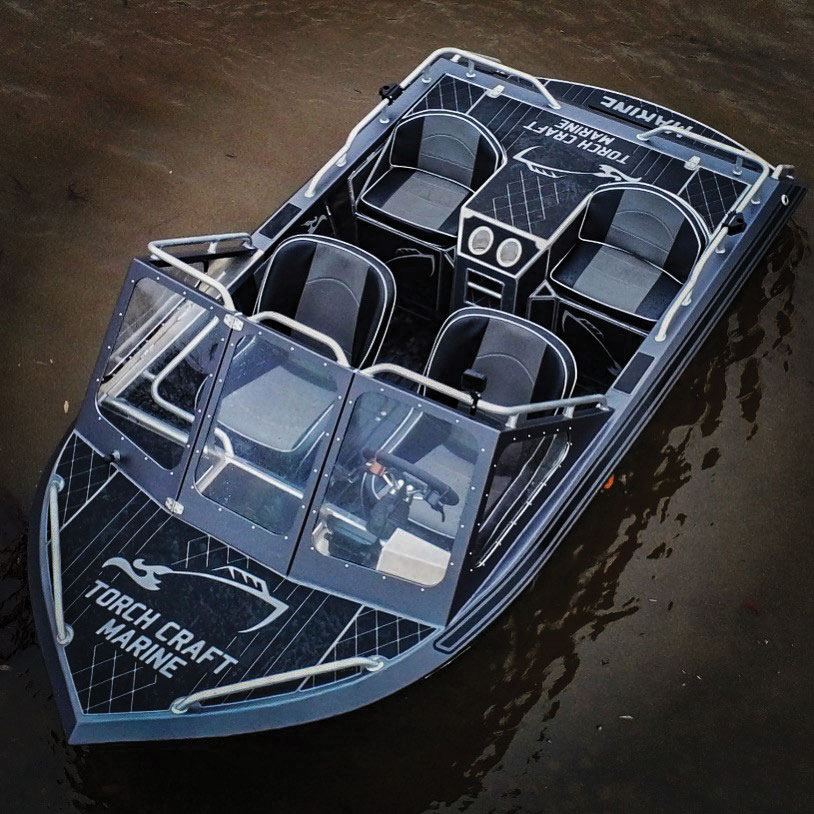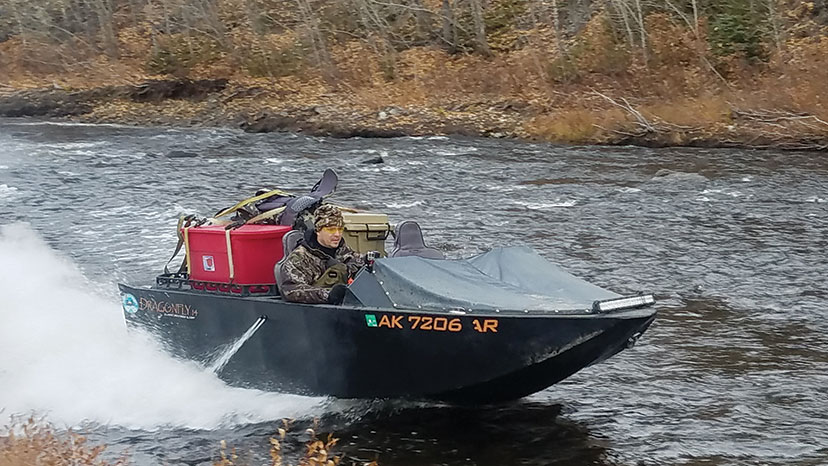Story by Troy A Buzalsky
This is the continuation of the Mini Jet Boats editorial from the May ’21 issue. Here we cover Atom Boats, FineLine Jetboats, Torch Craft Marine, and Class 5 Boatworks. It’s clear with this many manufacturers producing boats in this segment that mini-jet boating is on the rise.
Anchorage, Alaska, serves as home base for those exploring the Little Susitna, Willow Creek, Twentymile River, the Placer and countless other rivers and streams, and it’s also the birthplace of Atom Boats. An Alaskan from Anchorage, Nathan Blome owns and operates Atom Boats, a company dedicated to providing high-quality jet-boat kits for the do-it-yourselfer as well as established boat builders. By definition, Atoms are small, and a source of nuclear energy. By no coincidence, Atom Boats fill the mini jet-boat market, and their performance could be described as nuclear!

Anchorage, Alaska, serves as home base for those exploring the Little Susitna, Willow Creek, Twentymile River, the Placer and countless other rivers and streams, and it’s also the birthplace of Atom Boats. © Atom Boats
Nathan has been in the construction field throughout his adult life and grew interested in the mini-jet concept after seeing the ability of a mini jet built with a Tiger Shark motor. “It gave me the idea of remote access for fishing with my family as we normally fish the Kenai and have had great success with the 30-inch club there,” shares Nathan.
The first boat Nathan built came after he met Jamie Greenfield of MiniJet INC. At the time Jamie, who’s a forerunner in the mini-jet industry, was literally sharing his files. Nathan acquired a set of MiniJet Squirt files and built his first mini jet in the fall of 2013. “It was a trial-and-error project,” shares Nathan. “I used swear words I’d never said before!” Many mistakes were made in cutting and bending, but finally, after nine months the boat was complete. “And it turned out better than expected,” shares Blome.
Having started a Facebook page titled Alaska Mini Boats, Nathan quickly saw the interest of other Alaskans, as they were sharing their ideas and build projects. “Being involved with Alaska Mini Boats, I had access to help new boaters and saw the problems they faced with other kits. This led me to start designing my own hull. This also gave me the opportunity to meet some mini-jet builders across the world,” shared Blome. Nathan met Michael Morrow, owner of Liquid Violation Boats in New Zealand, and they clicked. “Morrow builds some of the world’s best mini-jet boats and after some great conversations the ideas and concepts for Atom were born,” explains Nathan. Features like a raked transom for improved floatation and engine space, a raised dash for increased leg room and space for gauges, a pickle-fork front end that not only looks wicked but also makes for easier assembly, and a shortened nose came from these brainstorming sessions.
In October of 2019, one year after Nathan’s first napkin concept drawing, he had CAD plans in hand, and he ordered two kits cut and shaped; one for him, and the other for his friend Petr, who now owns FineLine Boats. Suffice it to say, with two successful boats built, Atom Boats was launched, and business has exploded.
Atom Boats offers kits in 12’ and 13’ models. The kits come delivered to the customer CNC cut and folded. The hulls are manufactured from a 3/8” 6061 center delta, with 1/4” or 3/16” 5086 aluminum making up the balance of the hull. Everything you need to build the shell is included. Atom Boats also provides a UHMW template for US orders, and UHMV pre-drilled kits for its Canadian builders. Atom Boats can be adapted to Kawasaki, Yamaha and Rotax power-propulsion systems.
For distribution, Atom Boats are produced in the state of Washington and shipped worldwide. Atom Boats are also available as turn-key boats through FineLine Boats in Homer, Alaska, and Rocky Mountain Boats out of Meridian, Idaho. You can find Atom Boats online here: facebook.com/atomboats/.
Homer, Alaska, the small town at the “End of the Road” is a fascinating place where the east meets the west and the old meets the new. Where land ends Homer begins and is one of Alaska’s most-cherished destinations, notably referred to as the “Halibut Fishing Capital of the World.” Perched at the tip of the famous Homer Spit, the natural paradise of Kachemak Bay is a boater’s and angler’s paradise, and home to FineLine Jetboats, an up-and-coming mini-jet-boat builder located in the heart of paradise.

With attractions like China Poot, Sadie and Bear Cove, winter kings, and the scenic cliffs and caverns that surround Kachemak Bay, Homer, AK, may just become the next “Mini-Jet-Boat Capital of the World,” and FineLine Jetboats will be front and center. © FineLine Boats
Petr Afonin is the sole proprietor, owner-operator of FineLine Jetboats, and has been officially full-time since August of 2020. Being an avid angler and also fishing and deckhanding commercially in the Bristol Bay area, Petr started his boat-building pursuit like many, building his first mini-jet for himself as a personal project. In no time at all he was fielding requests for these unique and practical boats and made the decision as a young 25-year-old to venture out on his own, conquering a dream to own his own business.
Like many mini-jet-boat builders, Petr uses a precut and folded kit. Initially his first boats were built from Jetstream Adventure Boats aluminum mini-jet-boat kits, but more recently he’s been using the Atom mini-jet-boat kits. “I like the fact that they use a three-piece bottom, and the center section (the impact zone) is made from 3/8” aluminum,” shares Petr. All FineLine boats get an additional level of protection with either 3/8” or 1/2” UHMW on the boat’s bottom.
FineLine Jet Boats is a true custom mini-jet-boat builder. Once the hull kit is selected, typically FineLine uses the 12’ and 13’ models, the project starts turning dreams into reality. The kit size and style dictate the shape of the project, but the client’s imagination is the controlling factor. Options abound, from windshield to fuel-tank size, from the number of seats to electronics. FineLine also offers welded hulls that can be finished by the client.
FineLine will use Yamaha, Kawasaki, or Sea-Doo power plants. In fact, this is one piece of the puzzle where Petr lets the client have as much input as they’d like, often referring them to a Florida-based Facebook page, Powerplants R Us, who source new and used personal-watercraft power plants. “This way the customer is in charge,” shares Petr. “They pick the power they are looking for, and they purchase the motor. That way they know I’m not charging them any extra fees for sourcing the power plant and electronics, and they know the condition of what they purchased.”
Homer might be the Halibut Capital of the World, but with attractions like China Poot, Sadie and Bear Cove, winter kings, and the scenic cliffs and caverns that surround Kachemak Bay, it may just become the next “Mini-Jet-Boat Capital of the World,” and FineLine Jetboats will be the cornerstone. The next time you’re in Homer, chances are you’ll see Petr in his classic black-on-green mini jet, downrigger dropped, trolling up a catch. FineLine Jetboats can be found on Facebook at facebook.com/finelinejetboats.
If you have not heard the name Torch Craft Marine, I’m here to tell you it’s just a matter of time. Torch Craft Marine, located in the foothills of the Oregon Coast Range town of Philomath, is a new name in the mini-jet-boat manufacturing arena, and they are making big waves! I first saw Torch Craft on social media and my jaw literally dropped with the “shock and awe” they are putting into their “Mach 8, Light Your Hair on Fire” mini jets.

Being feature rich might just be an understatement. Torch Craft Boats are not only head-turners, they can also dish out a case of whiplash, offering ridiculous power and speeds over 60 mph. © Torch Craft Boats.
Torch Craft Marine is owned and operated by Troy Whitlock, who has nearly 30 years of experience in the welding and fabrication industry. His experience includes digital imaging, CAD drawing, prepress design, welding, and electrical. Prior to boat building, Troy owned and operated Torch Craft, a custom sign and metalwork company. Once he started building boats for himself and his friends, he decided to turn his passion into Torch Craft Marine.
Like other builders in the industry, Torch Craft Marine utilizes a precut and preformed, ready-to-weld hull kit from Jetstream Adventure Boats. But, unlike others, Torch Craft Marine has taken the Jetstream hull to the next level, taking the painstaking steps of registering their completed boats with United States Coast Guard (USCG), Environmental Protection Agency (EPA), and American Boat and Yacht Council (ABYC). Jetstream also incorporates a couple unique design features into their Torch Craft kits.
Currently, Torch Craft exclusively uses the 12’ Buccaneer hull which features a 6-foot beam and seating configurations for 2- to 4 adults. Whitlock likes the Buccaneer. “It’s a robust hull design that is ideal for the Pacific Northwest, and it serves as a well-rounded boat that is ideal for family outings, hunting, or fishing.”
Generally, Torch Craft has been using the 300 HP 1630 ACE Rotax motor and matched pump for their builds, citing the unmatched performance, superior fuel efficiency, and proven reliability. “These are proven performers,” Whitlock shares. However, the next build out of the Torch Craft shop will utilize a supercharged Rotax 230 HP, which is optimized to run on regular fuel. “Our customer is having this boat built to deliver building materials into the remotes of Nome, Alaska,” explains Whitlock. “In these remote reaches, premium fuel is not an option, and the Rotax 230 is that perfect option.”
“Custom Built for You” might be their tag line but looking at the Torch Craft gallery of past builds, “Uniquely Custom” might be a better description. Whitlock is quick to point out, “We build one boat at a time. Focusing all our attention on a single customer allows one-on-one attention to build your jet boat to the exact specs you want, with all the features you desire.” And being feature rich might just be an understatement. Torch Craft Boats are not only head-turners, they can also dish out a case of whiplash, offering ridiculous power and speeds over 60 mph.
The newest of the Torch Craft boats now feature the Torch Craft logo engraved in their transom and sides. Add to the bling list crazy and vivid custom wraps, UltraDeck accents throughout, LED lights above and below the water line, hard-thumping stereo systems, and stylish and comfortable PRP seats. But wait—there’s more. Hulls can be adorned with a low-brow windscreen or Lexan walkthrough windshield, handrails, cup holders, seat boxes and even LED light bars.
If you’re an adrenaline junky and you like to turn heads, look no further than Torch Craft Marine. Adventure made easy. Fast, fun, furious, and ready for action…and total beast mode; visit torchcraftmarine.com for more details.
Class 5 Boatworks is strategically located in Fairbanks, Alaska, and is a sister company to Lifewater Engineering Company, which designs, engineers, and fabricates plastic tanks for various applications. Having all the necessary skills, tooling, and talent, Class 5 Boatworks manager Jerry Fleishman pitched the idea of adding a boat line to their already successful business back in 2014. “If plastic is good enough for the bottom, why not build the whole boat out of it?” he shared to his team. The concept centered on building rough-duty boats for the rugged Alaskan wilderness that would be ideal for hunters, anglers, trappers, miners, lodges, cabin owners, or anyone who wants to explore waters unreachable in normal watercraft. Ultimately, the boating launch was christened in 2015.

The Chena River snakes through the middle of Fairbanks, AK, and serves as a recreational haven for anglers and boating enthusiasts. Riddled with narrow channels, logjams, overhanging vegetation, and shallows, the upper Chena can be challenging and dangerous, and is the ideal testing ground for Class 5 Boatworks. © Class 5 Boatworks
The Chena River snakes through the middle of Fairbanks, AK, and serves as a recreational haven for anglers and boating enthusiasts. Riddled with narrow channels, logjams, overhanging vegetation, and shallows, the upper Chena can be challenging and dangerous, and is the ideal testing ground for Class 5 Boatworks, which manufactures four boat models, including their go-fast, turn-on-a-dime DragonFly mini-jet boat.
What makes the Class 5 Boatworks DragonFly so unique is its construction. It’s 100% made from polypropylene sheet thermoplastic, cut and welded into the most indestructible boat possible. “Plastics have many advantages,” shares Fleishman. “The boats are more durable than their aluminum counterparts, and they ride smoother.” They also absorb sound and vibration making them quieter. This translates to a more comfortable ride, and a stealthier approach when sneaking up on your favorite fishing hole or hunting hotspot.
The initial DragonFly concept boat was designed in cooperation with MiniJet INC. Using the basic design of their Slingshot plans kit, a CAD model was created specifically for the new-to-the-industry polypropylene-hull design. Having the tooling and technologies already in house, the CAD files were loaded into the CNC machines and the kit was cut, ready for assembly. Class 5 Boatworks does not use rotomolded plastic; all material is sheet- and stock-dimensional polypropylene, cut, shaped, and welded into their indestructible hull design. “Plastic fabrication is time and process intensive,” cites Fleishman. “You can’t just go buy a plastic welder and build a boat from plastic. There is much more to it.”
For power, the DragonFly is available with one of three Rotax engine and jet-propulsion systems: the fuel-injected Rotax 150 HP, the supercharged 200 HP, or the supercharged and intercooled 250 HP model. All motors are OEM crate motors (not cannibalized jet skis), and meet and maintain all USCG and EPA requirements. The motors also come with a three-year factory warranty. Speaking of Coast Guard requirements, the DragonFly, at 14’ in length, requires floatation foam. Class 5 Boatworks uses CNC-cut, “perfect fit” pieces of 100% waterproof, non-absorbing polyethylene foam, filling the floatation voids perfectly.
The DragonFly is available with two- or three seats with a split console and an easy access open bow or with center console; windshields are optional. The boat’s engine box is also well conceived, having CNC-cut cleats wrapping all four sides, ideal for securing cargo or big game. Although a top is an option, most clients choose the spray skirt to hold in the heat and keep things fairly dry.
Carbon black is the standard color for the DragonFly, largely because it has the greatest UV protection possible. The boats can be painted or wrapped; sometimes the black hull with accent striping seems like the best way to customize the look.
There’s no doubt the plastic revolution has shaped our world, and it’s making a dent, or better said, not making a dent, in the boating arena. Weighing less than an aluminum counterpart, being able to take hard impacts without damage, and being warmer and quieter than other materials are just a few reasons you need to check out the DragonFly and other boats by Class 5 Boatworks, making all rivers possible. Details can be found at class5boatworks.com.
Troy Buzalsky is the Boats columnist for Fish Alaska magazine, and when not writing about boats or working his career in the fire service, Troy can likely be found chasing fish in the Pacific Northwest and the 49th state and writing about those adventures. Troy can be reached at troybuz@comcast.net.


